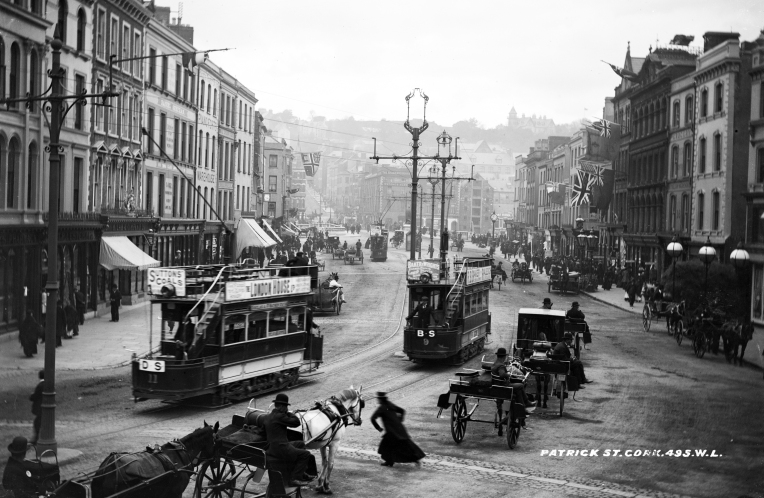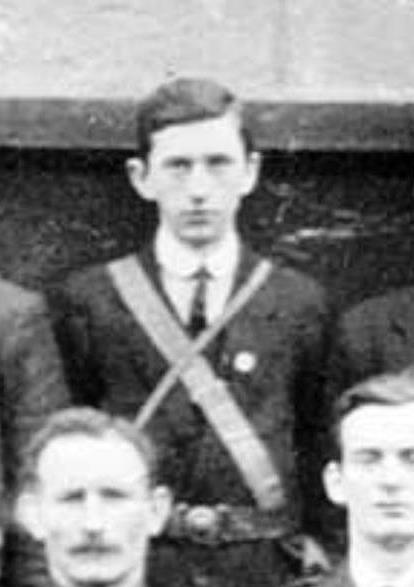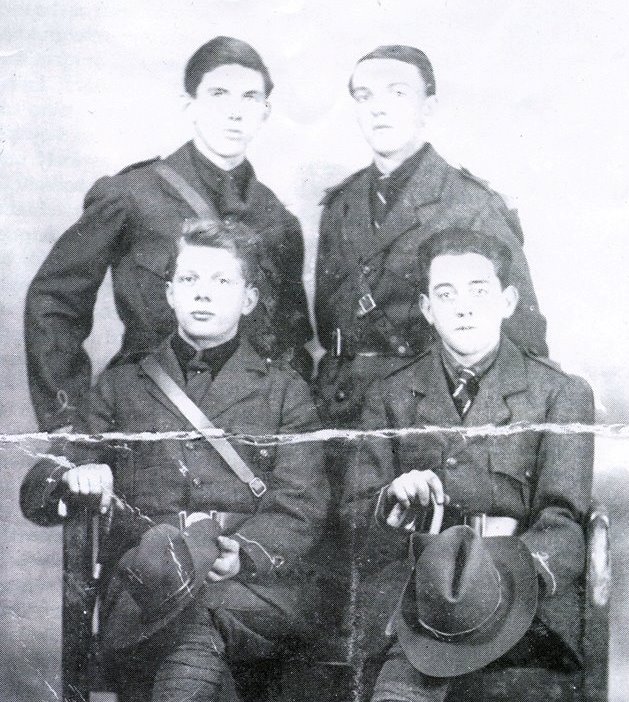Na Fianna Éireann in Cork City, 1910-1924 by Graham Harrington

Origins
Na Fianna Éireann in Cork City was established in 1910 by youth who were involved in the Cork branch of the Gaelic League. Cork at this time was referred to contemptously as “khaki Cork” for its lack of republican activity. The first nationalist organisation founded in Cork was the Cork Celtic Literary Society. Other groups such as the GAA, Conradh na Gaeilge(Gaelic League) were formed subsequently. Interest in cultural activities grew in time, with Margaret Buckley, organiser of the womens’ group Inghinidhe na hÉireann reporting that over 100 people were attending the groups’ Irish language and history classes. Following the activities of the Irish Republican Brotherhood in infiltrating organisations involved in the Cultural Revival, local republicans set about building a network.
In 1910, Na Fianna Éireann was established in Cork by republicans involved in the O’Growney Branch of the Gaelic League. Its key organisers included: Tómas MacCurtain, Seán O’Hegarty, Seán O’Sullivan, Paddy Corkery, Miceal Ó Cuill, Tadhg Barry, Martin Donovan, Miceall O’Neill, Donnchadh O’Donnaghue, and Ned Rochford. Walter Furlong was appointed the first scoutmaster in the city. Seán O’Sullivan was elected secretary and Tomás MacCurtain was elected treasurer. These were the main organisers in the city up until members joined the Irish Volunteers which was established in 1913.

Development
Recruitment was gradual, in 1912, 12 boys jumped ship from the Baden-Powell scouts after seeing the Na Fianna while on a visit to Dublin. After this, the numbers in Cork grew to around 30. They boys worked on increasing their profile around the city. Between 1912-1913, the boys put up anti-recruitment posters across Cork as part of an anti-British Army recruitment campaign. They also lived up to their reputation as scouts. Christy Monahan took over from Walter Furlong as scoutmaster. He encouraged training in map reading, knots, morse, semaphore, first-aid, tent pitching, tracking, scoutcraft, history and Irish classes. Members came mainly from poor, working-class backgrounds. They got their uniforms themselves, usually paying between 2ds and 3ds, although if this was too much, the organisation would cover costs. Parades and classes were held three nights a week, and route marches almost every Saturday, except in winter. Camps were held, such as in Blarney and Ballincollig. Discipline was strict, there was even an order that “members of Na Fianna would not appear on the streets in uniform while in the company of girls.”
However, this discipline stood to them. In 1913, during the annual public procession in Wilton, Fianna provided a guard of honour, which increased its public profile. It also laid wreathes at Fenian graves, in St. Finbarr’s Cemetery in the city and beyond. It held a commeration for the Manchester Martyrs. The boys regularly clashed with the Baden-Powell scouts, with Damian Lawlor writing: “In Cork City, proximity and opportunity also brought conflict. The Fianna headquarters was located only 200 yards from the offices of the Ancient Order of Hibernians’s scouts, and the Baden-Powell Scouts were also numerous. As a result, violence erupted on a regular basis between the groups.” They were also involved in a guard of honour for Gaelic scholars Kuno Keyer and Peter O’Leary which further helped its reputation.
Between 1913-1916, membership growth was steady, with numbers growing from 30 to about 100 with two slua in the city. The Irish Volunteers were founded in 1913, which gave a great boosts to the Fianna nationally and in Cork. Members of the Na Fianna assisted the Volunteers from the beginning. Members of the Fianna were present when the Volunteers were established at a meeting in Cork City Hall in 1913. When trouble broke out at the meeting, with fists flying, the Fianna preserved order and protected the panel, which included Roger Casement.The Fianna were allowed use of the Irish Volunteers’ premises in An Dún, Queen St. In 1914, which gave it its first official meeting place in Cork. At the first public parade of the Irish Volunteers, they were led by a lone Fian playing the bagpipes. The local boys also assisted the Volunteers with the anti-recruitment campaign, putting up posters and disrupting cinemas which showed recruitment films, pelting the screens with eggs. Members also assisted in the Buy Irish campaign. Seán O’Hegarty had a .22 rifle which the older boys used occasionally, they were also given a .22 by the caretaker of the ITGWU office caretaker. They boys were given use of the ITGWU’s offices as well for one of its slua. The other slua used the Volunteers’ premises in Sheare’s St. Fian Liam O’Callaghan succeeded Christy Monahan as scoutmaster, then followed by Seámus Courtney. Seámus Courtney and his close friend Seán Healy would establish themselves as vital organisers for Cork Na Fianna in this period. They organised throughout the city and beyond, in areas such as Blackrock, Youghal, Cobh and Riverstown.
The 1914 split in the Volunteers over Redmonds’ call to enlist in the British Army had little effect on Na Fianna, nationally and regionally in Cork City. Na Fianna was organised for a longer period than the Volunteers and there was a greater dedication to republican ideals, as opposed to the strong Redmondite constitutional nationalism which was present in the Volunteers. Na Fianna continued to have strong relations with the Irish Volunteers after the split. Its role after the outbreak of the war was to organise against the incessant recruitment drives, ahead of the possibility of conscription being spread to Ireland. However, as conditions changed, Na Fianna’s role changed significantly. Up to 1915, it was primarily a scouting organisation, with those interested in more militaristic activities joining the Volunteers as they became of age. However, in response to the growing militarisation of Irish society, Na Fianna shifted more towards a military organisation, with its key role being that of a training ground for future volunteers. Firing practice with small arms increased, with some of the older boys being given revolvers for personal use. This was in preparation for the rising of Easter Week.

Some of Cork’s Volunteer and Fianna officers in 1916
Easter and after
Ammunition had been moved throughout the city by na fianna in the week previous to the Rising. Older Fianna travelled to Cork, with 6 Fianna coming from Cobh. Up to 24 Fianna met with the Volunteers at Sheare’s St. With members carrying shotguns and revolvers, they marched with the Volunteers. However, Eoin MacNeill’s countermanding order caused confusion and the Rising in Cork was called off, with members being told to assemble again tommorow. On Easter Monday, the Rising began in Dublin. The Volunteers barricaded themselves in Sheare’s St, with the countermanding order preventing an attempt at a rising in Cork. The boys of Na Fianna were tasked with monitoring RIC activity along the railways and the barracks throughout Easter Week. In the aftermath of the Rising, the Fianna continued to parade and drill. Seámus Courtney and Seán Healy were arrested, with Courtney sentenced to 3 months hard labour. When Volunteers would return back from Frongoth to Cork, the Fianna would march to meet them. This caused obvious friction with the RIC, with baton charges against the crowd being common. On one occasion, slua commander PJ Murphy fired at and wounded an RIC man, wounding him. This was despite the Volunteers issuing strict orders to the boys not to use weapons without permission. Murphy was called to an inquiry, where he was temporarily stripped of his slua command. However, while on his way out, Tomás MacCurtain clapped him on the back, saying “I wish we could get the same spirit into the Volunteers.”
After 1916, Seámus Courtney (now released) and Seán Healy ran a concert to raise morale in the city. The concert was a success, with Markievicz herself attending. It succeeded in raising morale in the city and keeping the flame lit in the city after 1916. At this point, Cork had 2 slua, south and north of the River Lee, with about 100 members. Fian Charles Meaney said of this period “ During 1917 and 1918, our activities consisted of drilling, general training of a military nature, lectures in first aid and rifle shooting.” It was clear which way things were going, even after the Rising. Fianna’s headquarters were switched around several times, moving around from An Grianán, Queen St., South Main St., Pope’s Quay and North Main Street. Na Fianna was active in the 1918 General Election, distributing leaflets, putting up posters and participating in Sinn Féin’s propaganda efforts. This election was a significant success for republicanism, with SF winning 73 out of 108 seats, and the first Dáil Éireann formed. Na Fianna continued to wear its uniforms in this period, despite the British military’s ban on military attire.

Seamus Courtney
https://fiannaeireannhistory.wordpress.com/2014/08/09/seamus-courtney-1897-1918/
Guerilla War
As the guerilla phase of the revolution grew in intensity, na fianna played a key role. A 3rd slua was formed in early 1919, mainly as a reserve force of around 30. There was still strict discipline placed on the boys by the volunteers, with weapons having to be confiscated regurlarly for unauthorised use! Na Fianna had several roles in this period, as a supporting force for the IRA. Na Fianna carried out raids on private houses for arms. On one occasion on 7 March, 1920, 5 Fianna raiding a house owned by a prominent Loyalist for arms, in Douglas, were arrested. However, the local IRA visited the staff and ensured there was no incriminating evidence against the boys. On another occasion, a lorry carrying jam for British forces was stolen, with the provisions being given to families of IRA prisoners. Bicycles of Loyalists were also taken for IRA and Na Fianna use, such as for carrying messages between flying columns. Individual Black and Tans were also targeted and their weapons stolen when opportunity presented itself. Fian E. Keating disarmed a Black and Tan single-handedly on Maylor St. Fianna also carried out a successful operation against the GPO in Cork whichw as transporting communications between British units. British mail vehicles were burnt, with the contents destroyed. No Fianna or civilians were harmed in the operation which was carried out in a very disciplined way. However, this was a war, and Na Fianna in Cork City were not without tragedies.
Martyrs
Fian Seámus Courtney was born in Hibernian Buildings, Albert Rd. Ballintemple. He joined Na Fianna Éireann just after leaving school at age 15 in 1912. He established himself as someone with exemplary leadership qualities, not just in Na Fianna, but also in the Volunteers were he was later to become an officer. At the 1915 NFÉ Limerick Convention, he was elected Officer Commanding Munster. Seán Healy, his close friend and also a noted leader, took over Courtney’s former duties in Cork. He was in charge of mobilising the Fianna in Cork City during the Easter mobilisations and was responsible for re-organising in the city after 1916. As mentioned above, he served 3 months hard labour after being arrested in 1917. After release, a presentation was made to him by his comrades in the local Fianna. His organisational skills, such as in the concert after 1916, which re-energised Cork, and his organising of Na Fianna in county areas impressed the likes of MacCurtain and McSwiney, and he was co-opted onto the Battalion Council of the Irish Volunteers. He was arrested again in October 1917 and immediately began a hunger strike in protest, being released 4 days later. However, his health rapidly declined after this in response to the hunger strike, his time hard labouring, ill treatment while in prison and the stress of his constant organising duties. He had a job with the ITGWU which he was forced to resign, also resigning his Fianna position due to his health. He left Cork to live on his aunt’s farm in Co. Kerry, where he wasn’t forgotten by his comrades, with Seán Healy being a visitor. Seámus Courtney passed away on 18 July, 1918. His funeral was large, with Na Fianna and republican Cork paying their respects to their fallen and tireless comrade. In recogntion of his abilities, he kept his rank of O/C Munster until his death. Three revolver volleys were fired over his coffin in salute, with the RIC unable to capture any of the firing party. This was significant as it was the first time since Easter Week that guns were brought back into the struggle, and by Cork Na Fianna. A local newspaper said of Courtney’s funeral: “The cortege was the most imposing and impressive witnessed in Cork for years. The final scenes at the graveside were touching in the extreme.”
Unfortunately, this was not an isolated tragedy. Fian Joseph Reid was one of 4 Cobh section leaders and one of the firing party in Seámus Courtney’s funeral. While cleaning his revolver, it went off and he was killed. He was only 17 years old. His brother, also a young Fian, removed the revolver before the RIC could arrive. He died just 2 days after Courtney, on 20 July, 1918. His funeral was also impressive, with Na Fianna, Cumann na mBán and the Volunteers being present. Joe raid place in Cobh is named after him.

Four prominent members of the Cobh Fianna Eireann branch in 1917 https://fiannaeireannhistory.wordpress.com/2014/06/30/na-fianna-eireann-in-cobh-co-cork/
In Co. Galway, a Cork Fian called Seámus Quirke was killed by British auxiliaries on 9 September 1920. He was 23 years old and worked in a jewellers. He was killed in reprisal for the killing of Krumm, an RIC man who was noted for targeting civilians. Seámus Quirke is buried in St. Finbarr’s Cemetery, Cork.
Fian Christopher Lucey was shot dead by British forces at Tureen Dubh, Ballingeary on 10 November 1920. He was 22 years old and from No. 3, Pembroke St. He was “one of a family who for generations made sacrifices for the Irish cause.” A medicine student at UCC, he was imprisoned previously and transferred to Mountjoy, where he was released after a hunger strike. He went on the run and during this time was made a section commander of the IRA. In one notable incident, he took part in a hold-up of Auxiliary transports, disarming them and securing 2 lorries. He was staying with cousins in Ballingeary when he was killed while “trying to escape”, British code for executed. It was said at the time that “it may be thought that the incident connected with his death would strike terror into the hearts of his countrymen, but, on the contrary, it will only nerve his countrymen to continue their resistance and perservere to the end.” Cork Republican Tadhg Barry also said defiantly of his death “the people who shot him may shoot us and kill us , but they will never succeed in terrorising us.”
Only a week after Christopher Lucey’s death, Fian Patrick Hanley was to be killed. He was 17 years old when he was killed by the Black and Tans in his home in Grattan/Broad St. This was part of a series of murders by the Black and Tans in the area, with a civilian and former British soldier, Eugene O’Connell also being killed on the same day. Hanley, as the sole man of the house, was the sole support of his widowed mother and sisters. In retaliation for the IRA killing of an RIC man, a police spy gave away the identity of the IRA volunteers responsible. Hanley’s home was mistaken for the home of one of the volunteers and was broken into, Haney was confronted by the Black and Tans who shot him. He died instantly. A Na Fianna guard of honour was present at his funeral, where the local Fianna said that “in the service of Ireland he lost his life.” A volley of shots were fired over his grave in St. Finbarr’s Cemetery. Years later, a plaque was erected at his home and scene of his murder by members of the Cork Old Na Fianna Association, with the tricolour that was present on the day the very same tricolour that was draped over his coffin.
Winding down and further tragedies
The 1922 Truce was overwhelmingly rejected by the Na Fianna. The vast majority of members opposed it. The new Free State was in no way more lenient than the British to the Fianna. During a Fianna Ard Fheis, a Cork delegate was wounded when Free State forces opened fire on the building. This was because Michael Collins was travelling around Dublin city centre and the Free State wished to distract the republicans.
In was in this context that Fian Richard Noonan lost his life. Richard Noonan was from ’98 Street in the city. Along with other republicans, he was imprisoned by the Free State in Cork county gaol, in what is now UCC. He had only been imprisoned for short period, with his father saying at the inquiry into his death that he only saw his son 6 weeks before. Richard Noonan died on 11 October 1922. The cause of death was determined to be heart disease. He was only aged 18 years old at this time. Noonan’s Road in Cork City, where he lived, was named after him.

The end of the Civil War didn’t end the tragedies in Na Fianna. Fian James Pyne lived in the Old Youghal Road, Mayfield. He held the rank of adjutant in NFÉ and played for the local Sarsfield H&F club, who passed a motion of sympathy after his death. (thanks to Colum Radford for this information) James Pyne was involved in the republican hunger strike in Newbridge, where over 1,700 were on the strike, with 70 on hunger strike in Cork gaol. This strike was held to secure amnesty for republican prisoners and end the civil war. The damage done to Fian Pyne did irreperable damage to his health and he passed away on 10 November, 1924. He is buried in St. Finbarr’s Cemetery.
Research and story by Graham Harrington (c)
Further reading:
https://fiannaeireannhistory.wordpress.com/2014/11/27/fianna-eireann-in-cork-city-by-charles-meaney/
https://fiannaeireannhistory.wordpress.com/2014/08/09/seamus-courtney-1897-1918/
https://fiannaeireannhistory.wordpress.com/2014/06/30/na-fianna-eireann-in-cobh-co-cork/
https://fiannaeireannhistory.wordpress.com/2015/05/06/patrick-hanley-1903-1920/